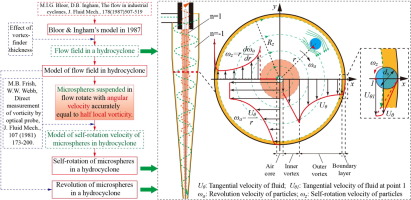Separation and Purification Technology ( IF 8.6 ) Pub Date : 2020-01-11 , DOI: 10.1016/j.seppur.2020.116552 Yuan Huang , Hua-lin Wang , Jinyi Tian , Jianping Li , Pengbo Fu , Fengqin He

|
Porous particles containing organic waste, such as residue hydrogenation waste catalysts and oily sludge, are important hazardous pollutants. In 2017, self-rotation and revolution of particles in hydrocyclones were first experimentally measured and numerically studied for enhancing the hydrocyclone separation function of removing coating oil on spent hydrocracking catalysts. To date, however, their mechanisms are still not clearly explained using mathematical models. Accordingly, in this study, a modified mathematical model of 3-D swirling flow field in a hydrocyclone was established based on Bloor & Ingham’s model proposed in 1987, and a non-inertial self-rotation-velocity prediction model of microspheres in the hydrocyclone was established by coupling the swirling flow field and particle motion. The flow field, microspheres revolution, microspheres self-rotation, and coupled centrifugal separation in the hydrocyclone were calculated using the aforementioned two models. Results show that, compared with Bloor & Ingham’s model proposed in 1987, fluid velocities calculated using the modified model were closer to the experimental results. In the cylindrical coordinate system, the self-rotation velocity of microspheres in the forced vortex of hydrocyclones was zero; whereas that in the quasi-free vortex decreased as the revolution radius increased; that in the boundary layer rapidly increased to above 1000 rad/s with the increase of revolution radius, which was dozens of times the revolution velocity. Where the direction of inertial microsphere self-rotation in quasi-free vortex and boundary layer was opposite to the revolution direction. Besides, it could also be concluded that the periodic-oscillation coupling centrifugal force, which was generated by the revolution and high-speed self-rotation of particles near the wall, promoted the outward migration of pollutants in pores of the particles, and the calculation equation of its oscillation period was obtained. Therefore, the hydrocyclone-removal mechanism of particle-pore pollutant was revealed.
中文翻译:

水力旋流器中颗粒自转与公转的离心耦合特性的理论研究
含有有机废物的多孔颗粒,例如残留的加氢废物催化剂和油性污泥,是重要的有害污染物。2017年,首先对水力旋流器中颗粒的自转和公转进行了实验测量和数值研究,以增强水力旋流器分离功能,以去除用过的加氢裂化催化剂上的涂层油。然而,迄今为止,仍未使用数学模型清楚地解释其机理。因此,在本研究中,基于1987年提出的Bloor&Ingham模型,建立了水力旋流器中3-D旋流场的修正数学模型,并建立了水力旋流器中微球的非惯性自转速度预测模型。通过将旋流场与粒子运动耦合而建立。流场,微球公转,使用上述两个模型计算了微球的自转和旋液分离器中的耦合离心分离。结果表明,与1987年提出的Bloor&Ingham模型相比,使用改进模型计算的流体速度更接近实验结果。在圆柱坐标系中,水力旋流器强迫涡旋中微球的自转速度为零;准无旋涡中的旋涡随着旋转半径的增加而减小。随着旋转半径的增加,边界层中的碳迅速增加到1000 rad / s以上,是旋转速度的几十倍。准无涡旋和边界层中惯性微球自转的方向与公转方向相反。除了,还可以得出结论,由于壁附近颗粒的旋转和高速自转所产生的周期性振动耦合离心力,促进了污染物在颗粒孔中的向外迁移,并且计算公式为获得其振荡周期。因此,揭示了水力旋流器去除颗粒孔污染物的机理。



























 京公网安备 11010802027423号
京公网安备 11010802027423号